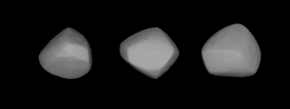 A three-dimensional model of 345 Tercidina based on its light curve | |
| Discovery | |
|---|---|
| Discovered by | Auguste Charlois |
| Discovery date | 23 November 1892 |
| Designations | |
| (345) Tercidina | |
| Pronunciation | /tɜːrsɪˈdaɪnə/ |
Named after | (unknown) |
| 1892 O | |
| Main belt | |
| Orbital characteristics [1] | |
| Epoch 31 July 2016 ( JD 2457600.5) | |
| Uncertainty parameter 0 | |
| Observation arc | 122.88 yr (44882 d) |
| Aphelion | 2.46765 AU (369.155 Gm) |
| Perihelion | 2.18337 AU (326.628 Gm) |
| 2.32551 AU (347.891 Gm) | |
| Eccentricity | 0.061120 |
| 3.55 yr (1295.3 d) | |
| 288.675 ° | |
| 0° 16m 40.526s / day | |
| Inclination | 9.74765° |
| 212.629° | |
| 230.279° | |
| Physical characteristics | |
| Dimensions | 126x94x90 km
[2]
[3]
[1] 94 km (mean) [1] 98.78 ± 2.63 km [4] |
| Mass | (2.68 ± 1.18) × 1018 kg [4] |
Mean
density | 5.30 ± 2.37 g/cm3 [4] |
| 12.371 h (0.5155 d) [1] | |
| 0.0654±0.007 [1] | |
| C [1] | |
| 8.71 [1] | |
Tercidina ( minor planet designation: 345 Tercidina) is a large main-belt asteroid. It is classified as a C-type asteroid and is probably composed of carbonaceous material.
It was discovered by Auguste Charlois on 23 November 1892, in Nice.
Size
Observations of an occultation of a bright 5.5 magnitude star on 17 September 2002, produced seventy-five chords indicating an ellipsoid of 111×90 km. [3]
Observations of an occultation on 15 November 2005, near Grass Valley, California, produced five chords indicating an incomplete outline of 126×111 km. [2] This larger result may be caused by a different orientation of the asteroid as it passed in front of the star.[ citation needed]
References
- ^ a b c d e f g "JPL Small-Body Database Browser: 345 Tercidina (1892 O)" (2008-08-26 last obs). Archived from the original on 16 September 2011. Retrieved 6 May 2016.
- ^ a b Richard Nugent (15 November 2005). "345 Tercidina 2005 Nov 15". Richard's Astronomy Pages. Archived from the original on 27 December 2008. Retrieved 3 December 2008.
- ^ a b "2002 European Asteroidal Occultation Results". euraster.net (a website for Asteroidal Occultation Observers in Europe). 17 September 2002. Retrieved 3 December 2008. (Chords)
- ^ a b c Carry, B. (December 2012), "Density of asteroids", Planetary and Space Science, vol. 73, pp. 98–118, arXiv: 1203.4336, Bibcode: 2012P&SS...73...98C, doi: 10.1016/j.pss.2012.03.009. See Table 1.
External links
- 345 Tercidina at AstDyS-2, Asteroids—Dynamic Site
- 345 Tercidina at the JPL Small-Body Database
 A three-dimensional model of 345 Tercidina based on its light curve | |
| Discovery | |
|---|---|
| Discovered by | Auguste Charlois |
| Discovery date | 23 November 1892 |
| Designations | |
| (345) Tercidina | |
| Pronunciation | /tɜːrsɪˈdaɪnə/ |
Named after | (unknown) |
| 1892 O | |
| Main belt | |
| Orbital characteristics [1] | |
| Epoch 31 July 2016 ( JD 2457600.5) | |
| Uncertainty parameter 0 | |
| Observation arc | 122.88 yr (44882 d) |
| Aphelion | 2.46765 AU (369.155 Gm) |
| Perihelion | 2.18337 AU (326.628 Gm) |
| 2.32551 AU (347.891 Gm) | |
| Eccentricity | 0.061120 |
| 3.55 yr (1295.3 d) | |
| 288.675 ° | |
| 0° 16m 40.526s / day | |
| Inclination | 9.74765° |
| 212.629° | |
| 230.279° | |
| Physical characteristics | |
| Dimensions | 126x94x90 km
[2]
[3]
[1] 94 km (mean) [1] 98.78 ± 2.63 km [4] |
| Mass | (2.68 ± 1.18) × 1018 kg [4] |
Mean
density | 5.30 ± 2.37 g/cm3 [4] |
| 12.371 h (0.5155 d) [1] | |
| 0.0654±0.007 [1] | |
| C [1] | |
| 8.71 [1] | |
Tercidina ( minor planet designation: 345 Tercidina) is a large main-belt asteroid. It is classified as a C-type asteroid and is probably composed of carbonaceous material.
It was discovered by Auguste Charlois on 23 November 1892, in Nice.
Size
Observations of an occultation of a bright 5.5 magnitude star on 17 September 2002, produced seventy-five chords indicating an ellipsoid of 111×90 km. [3]
Observations of an occultation on 15 November 2005, near Grass Valley, California, produced five chords indicating an incomplete outline of 126×111 km. [2] This larger result may be caused by a different orientation of the asteroid as it passed in front of the star.[ citation needed]
References
- ^ a b c d e f g "JPL Small-Body Database Browser: 345 Tercidina (1892 O)" (2008-08-26 last obs). Archived from the original on 16 September 2011. Retrieved 6 May 2016.
- ^ a b Richard Nugent (15 November 2005). "345 Tercidina 2005 Nov 15". Richard's Astronomy Pages. Archived from the original on 27 December 2008. Retrieved 3 December 2008.
- ^ a b "2002 European Asteroidal Occultation Results". euraster.net (a website for Asteroidal Occultation Observers in Europe). 17 September 2002. Retrieved 3 December 2008. (Chords)
- ^ a b c Carry, B. (December 2012), "Density of asteroids", Planetary and Space Science, vol. 73, pp. 98–118, arXiv: 1203.4336, Bibcode: 2012P&SS...73...98C, doi: 10.1016/j.pss.2012.03.009. See Table 1.
External links
- 345 Tercidina at AstDyS-2, Asteroids—Dynamic Site
- 345 Tercidina at the JPL Small-Body Database